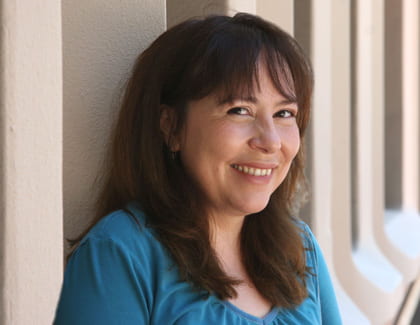Giving students their wings
Evolutionary biologist Adriana Mejía Briscoe studies butterflies while helping launch young researchers’ careers

While many scientists are drawn to study butterflies for the beauty of their wings, Adriana Mejía Briscoe’s focus is a bit different. She’s looking into their eyes.
Briscoe, ecology and evolutionary biology associate professor, researches butterfly vision to find out how the insects see, and thereby gains insights into molecular evolution. Along the way, she’s helped many students evolve – into successful researchers.
Undergraduate and graduate students, postdocs and technicians have all seen their academic and professional careers soar thanks to her training and willingness to steer them toward important research projects.
Because of her own impressive research and mentoring activities, she recently received the 2008 Diversity Award from the Federation of American Societies for Experimental Biology, the principal umbrella organization of U.S. societies in biological and medical research. Sponsored by the Burroughs Wellcome Fund, the award recognizes outstanding achievement by an early career life scientist from an underrepresented minority group.
Briscoe “makes use of the beauty of butterflies and their spectacular biology to attract and mentor underrepresented minorities in science,” wrote Susan V. Bryant, research vice chancellor, in her nomination letter to FASEB. Briscoe has mentored students through the Minority Science Programs, a joint effort by the UCI School of Biological Sciences and National Institutes of Health to increase underrepresented groups in biomedical research careers. She’s also served as advisor to students in the Undergraduate Research Opportunities Program and landed National Science Foundation grants for undergraduate researchers to pursue projects in her lab.
“I don’t give them only make-do work. I give them really exciting research projects that have impact. And I have high expectations,” she says. Those who meet her standards have found their work published in scientific journals.
“One of the best things you can do for students is help them get published, because it can translate into jobs, awards and grants.”
Briscoe’s lab is one of the few in the world studying the evolution of red-green color vision in butterflies and their closest relatives, moths and skippers.
“The butterfly eye is a marvel of evolution,” she recently wrote. “Butterfly eyes are nearly as diverse as the color of their wings.” One of her major studies — on the cause of lycaenid butterfly eyes’ increased color sensitivity and the evolution of their brilliantly colored wings — earned her graduate student Marilou Sison-Mangus the prestigious Outstanding Paper Prize from theJournal of Experimental Biology.
Briscoe appreciates the importance of mentoring because she, too, found a mentor at Stanford University, where she earned a bachelor’s in biological sciences and bachelor’s and master’s in philosophy. Her biology professor, Ward Watt, won NSF funding so she could conduct field work with him at the Rocky Mountain Biological Laboratory in Gothic, Colo.
“We would collect butterflies, looking at their behavior and studying their ecology,” she says. “It was magical.”
Briscoe received her doctorate at Harvard University in 1999 and began teaching at UCI in 2002. She’s currently interested in butterflies that “have evolved to look like other butterflies to avoid birds that prey on them.”
“Birds recognize patterns on their wings that communicate ‘this is an unpalatable animal.’ We’re starting to study the consequences of that on color vision,” she says.
Her research has helped show that butterflies see the world in different colors, and it has implications for the way human vision has evolved. It’s an impressive contribution of scientific knowledge, all in the eyes of a butterfly.